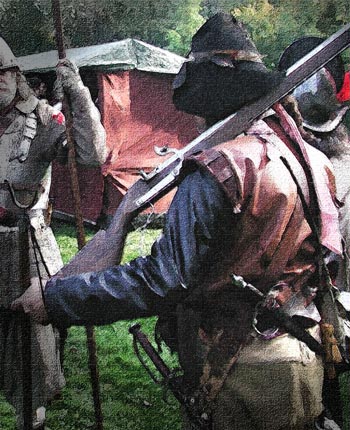| Infantry |
Before the advent of the bayonet, infantry consisted of two types of arms during the 16th century and nearly all of the 17th century: polearms and firearms. By the time of the Battle of Breitenfeld, the principle polearm was the pike and the hand-held firearm of choice was the musket.
To the uninitiated, the pike appears to be a spear but was not for throwing. Four to six meters (or more) in length, the pike was used to fend off cavalry and to push into other infantry. Indeed, during the 16th century, it was considered the decider of battles. But one pike was useless, whereas a concentration of them - used in unison - was required for any effect. Pikemen were organized into ranks and files, in rectangular groups as large as many as 50 men making a rank and more than 30 making a file. The Spanish codified such formations as 'Tercios." More than 1,500 men fought in concert as one entity, which could and did humble horse and dominate the battlefield.
 For the end of the 15th century and more than half the following century, the
arquebus and caliver were the principle handheld firearms. Small in bore and
light in weight, they could be handled by troops with less training than a
longbow, and the weapons had simpler mechanisms than the cranked crossbow. But the small
bore and weight meant those weapons did not have much range nor penetrating
power. With a bit of an increase in armor thickness, heavy cavalry and pike
could usually withstand a hit from an arquebus ball. Indeed, freshly made armor
was announced as “bullet-proof” by the maker firing a light gun at it,
rendering
a dent but not a hole.
For the end of the 15th century and more than half the following century, the
arquebus and caliver were the principle handheld firearms. Small in bore and
light in weight, they could be handled by troops with less training than a
longbow, and the weapons had simpler mechanisms than the cranked crossbow. But the small
bore and weight meant those weapons did not have much range nor penetrating
power. With a bit of an increase in armor thickness, heavy cavalry and pike
could usually withstand a hit from an arquebus ball. Indeed, freshly made armor
was announced as “bullet-proof” by the maker firing a light gun at it,
rendering
a dent but not a hole.
At first, use of shot on the battlefield was essentially “fire when you’re ready” resulting in a sporadic pepper of fire into the enemy. Good for harassing and “softening” the opposition but the crux of the battle lay with the use of horse and pike -
-Until muskets replaced the weaker arquebuses and calivers, and cannons proliferated. And delivery of fire was coordinated into an orderly process.